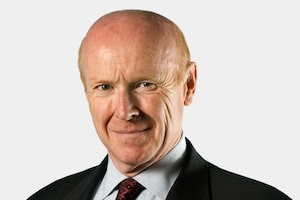Dan Richards is president of Strategic Imperatives. He is a faculty member in the MBA program at the Rotman School at the University of Toronto. He also hosts a weekly conference call called Monday Morning Jump Start, which is about strategies for financial advisors. Advisors can see it GlobeAdvisor.com. He can be reached at richards@getkeepclients.com
There is one universal truth across every investment approach and that truth is the need to be steadfast in your resolve. Markets never move in a straight line - there are always bumps in the road (sometimes very big bumps) that will trip up all but the most committed of investors.
Consider for example the conviction it took for U.S. hedge fund manager John Paulson and Canada's own Prem Watsa, who made big investments based on their view that the U.S. housing market would collapse and cause devastation to financial markets. This was the same kind of conviction it took for Warren Buffett to stay out of tech stocks during their boom, underperforming as a result and taking abuse from journalists writing that "he'd lost it."
Mr. Paulson, Mr. Watsa and Mr. Buffett all profited mightily from these calls, as did their investors - but all were early and initially suffered big losses until ultimately proven right. Profiting from any investment approach means that you have to be prepared to stick to your guns and look stupid while the market goes against you.
This is the sort of thinking that was bouncing around my head recently after a luncheon conversation with an investment industry insider about what superstar investors Mr. Buffett, Mr. Watsa and billionaire George Soros have in common.
They're all men, obviously, all well along in years and all hugely successful - but that's about where the similarities end.
Mr. Buffett is essentially a traditional bottom-up manager, conducting in-depth analysis on a stock-by-stock basis (although he has occasionally deviated into things like speculation against the U.S. dollar). Mr. Soros is noted for his big-picture calls on markets like currencies. And Mr. Watsa is somewhere between the two - with a reputation as value manager but also someone who's recently profited from large bets against the U.S. real estate and financial markets.
What they do share are exceptional analytical ability combined with strong, almost unshakeable convictions.
At the other extreme are money managers whose funds look very much like the indexes against which they're compared. Sometimes tarred with the pejorative description "index-huggers" or "closet indexers," the portfolios of these managers closely track the composition of the stock market mandates they've been given.
On this issue, there's been an important evolution among today's most sophisticated investors - endowments, pension funds and high-net-worth investors divide managers into two categories, those who generate alpha and those who provide beta.
Beta is what you can get from a market index without any intervention by a manager. Skilled investors don't pay active management fees for market-like returns, rather they buy overall market performance through index funds and exchange-traded funds at the lowest possible price. For large institutions, that price is well under one-tenth of 1 per cent, so these investors might pay $500 or less for every million dollars being managed.
Of note, individual investors can track the U.S. markets almost as cheaply - a Vanguard index fund replicating the U.S. market has annual management fees of $9 (U.S.) per $1,000, although you do have to pay a commission to buy it.
Money managers who charge substantial fees but whose portfolios closely resemble the overall index, those "closet indexers" who provide beta, don't last long under the steely gaze of these knowledgeable investors.
Alpha, on the other hand, is all about above-market returns delivered through in-depth analysis, stock-picking prowess and strong points of view. Sophisticated investors are prepared to pay richly for alpha - it's here that hedge fund managers sometimes come into play, with their "2 and 20" compensation. (The typical hedge fund earns an annual fee of 2 per cent plus a performance fee of 20 per cent of returns above a specified level, most commonly 6 per cent.)
In the short term, hugging the index can reduce stress on a manager - being close to the index means you're never going to deviate too far from the market returns, so are unlikely to be the target of investor acrimony. And "risk managers" at head offices of large institutions sleep better at night knowing that their money managers won't deviate too far from average.
Over time, however, the fees they charge to simply mimic an index guarantee these managers will underperform and limit their career prospects.
The hard truth is that delivering long-term superior returns means taking a stance that at some point will almost certainly underperform the benchmark that you're being compared to. In fact, in 2007 two Yale professors published a study looking at the return of funds based on how "active" they were, in other words, the extent to which they deviated from their index. Their conclusion: The most active managers - those with the most conviction in structuring portfolios - outperformed their index after expenses; the least active managers, or those closest to the index, cost investors money.
Remember, there is more than one route to investing success - the key is identifying the managers that bring a track record of success and who aren't afraid to build strong convictions into their portfolios and to be wrong in the short term.
Finally, once you've found those managers, you need to be prepared to stay the course even when the market turns against them - after all, anyone can hang in when things are going well, it's when things turn choppy that investors' own convictions are tested.
 Dan Richards
Dan Richards